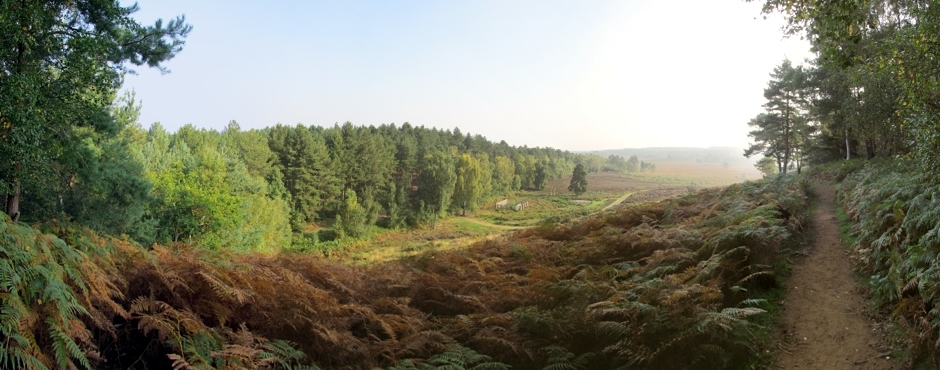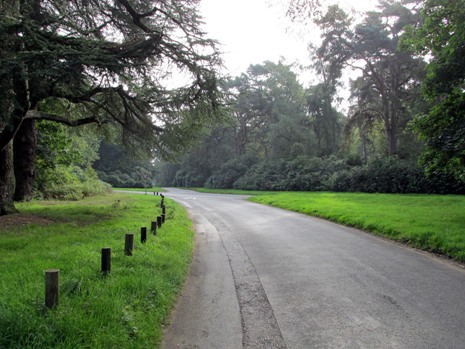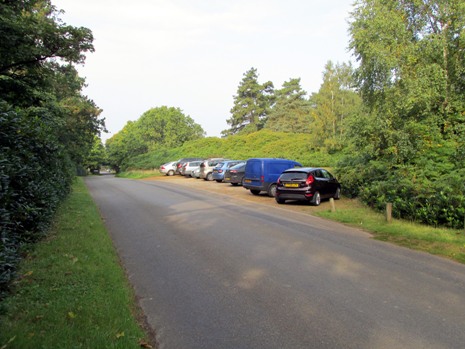Dersingham Bog National Nature Reserve
Dersingham Bog is a National Nature Reserve in the English county of Norfolk. It forms part of what was once a much larger heathland that stretched the entire length of the Greensand escarpment from King’s Lynn to Heacham in the North West of the county. Much of the ancient heathland has been lost to agriculture and forestry and Dersingham Bog National Nature Reserve is one of the largest remaining areas of lowland heathland left in Great Britain.

Above: Panoramic Stitch Photograph Looking Down Towards Dersingham Bog.
This Site of Special Scientific Interest contains three distinct, but closely intermingled habitats - mire, heath and woodland. The mixture of these provides ideal conditions for a wide variety of flora and fauna. The area forms part of the Sandringham Royal Estate and is managed by staff of English Nature. The thumbnail gallery below shows a selection of photos taken during a walk around the nature reserve on 04th October 2015 and a description of each of the three habitat types follows.
The Valley Mire lies over much of the low lying parts of the reserve. The watertable is close to the level of the ground here, making the land boggy and waterlogged for much of the year. The marshy land here is an acid valley mire and forms the largest and most intact example of this type of habitat in the east of England. The mire’s wet acid peat results in it having it’s own special flora which includes round-leaved sundew (Drosera rotundifolia), white beak-sedge (Rhynchospora alba), bog asphodels (Narthecium ossifragum) and cranberry. The habitat here contains a number of rare insects, including dragonflies (such as the black darter dragonfly, Sympetrum danae), water beetles and the indigenous micro moth (Choristoneura lafauryana) which feeds on bog myrtle. The micro moth presented challenges to the construction of a new bypass section of the adjacent A149 road in the latter part of the 20th century, when the environmental impact on this unique species’ survival became a debated issue prior to it going ahead many years later than originally planned. Peat was cut here many years ago and it is thought this may have actually helped the mire, by lowering the ground surface thus helping maintain wet conditions. On one side of the mire is a high escarpment which is essence is an ancient coastline (the sea is actually several miles away today), effectively surrounding the acid valley mire with high woodland. The Valley Mire is carefully managed to ensure the water levels are controlled and that invasive species, such as Scots pine and rhododendron, which are found in abundance in the adjacent Sandringham Country Park, are kept at bay.
The Heathland here, by definition, is an open area of ground dominated by heather, gorse bushes and scattered groups of trees. This habitat type is generally found on poor sandy soils. The habitat found here is thought to have been formed as a result of the clearance of medieval forests by people who used the area for grazing and burning management. In England today, heathland is a much reduced and threatened habitat and without careful management, such as that employed at this nature reserve, such a habitat would naturally revert back to woodland; if not managed, Silver birch, Scots pine and rhododendron scrub would quickly encroach the site and it would only take 30 years or so for the heathland to be lost. The heathland found at Dersingham Bog National Nature Reserve provides an ideal site for rare insects and nesting shelduck and night jar.
The Woodland found here is relatively recent, bar a few relic trees including thinly scattered Oak trees which are a possible descendant of original native forest. Birch trees are common and thought to possibly represent an ancestral component of the original native forest too. Other trees found here are the more recently introduced sweet chestnut, sycamore and rhododendron. Although there are some plantations of Scots Pine here as well, most of the trees that are to be seen have seeded naturally. Scots Pine invasion at Dersingham Bog National Nature Reserve produces a result indistinguishable from that in the areas of Scotland where it is still native. Indeed, on some sections of the walks in the nature reserve, one can almost imagine they are north of the border! The woodland contains carefully maintained wide open glades which attract birds such as redpoll, crossbill, long-eared owl, tree pipit, woodlark, shelduck, nightjar and sparrowhawk. Populations of fallow and roe deer and muntjac are found here as well in healthy numbers.
 |
 |
The nature reserve has a number of well-marked woodland walks available for visitors. These are accessible from the free roadside car parks at the Scissors Crossroads [Left Photo, Above] and at Wolferton Hill [Right Photo, Above]. These are approached via either of two roads which connect the village of Wolferton to the main A149 road as it passes through the Sandringham Royal Estate. Access to the more sensitive sanctuary areas of the reserve is only via a guided walk organised by the Site Manager or by obtaining a research permit. Visitors are politely reminded to keep within the area of the woodland pathways and follow the signposted walks.
Back to Top